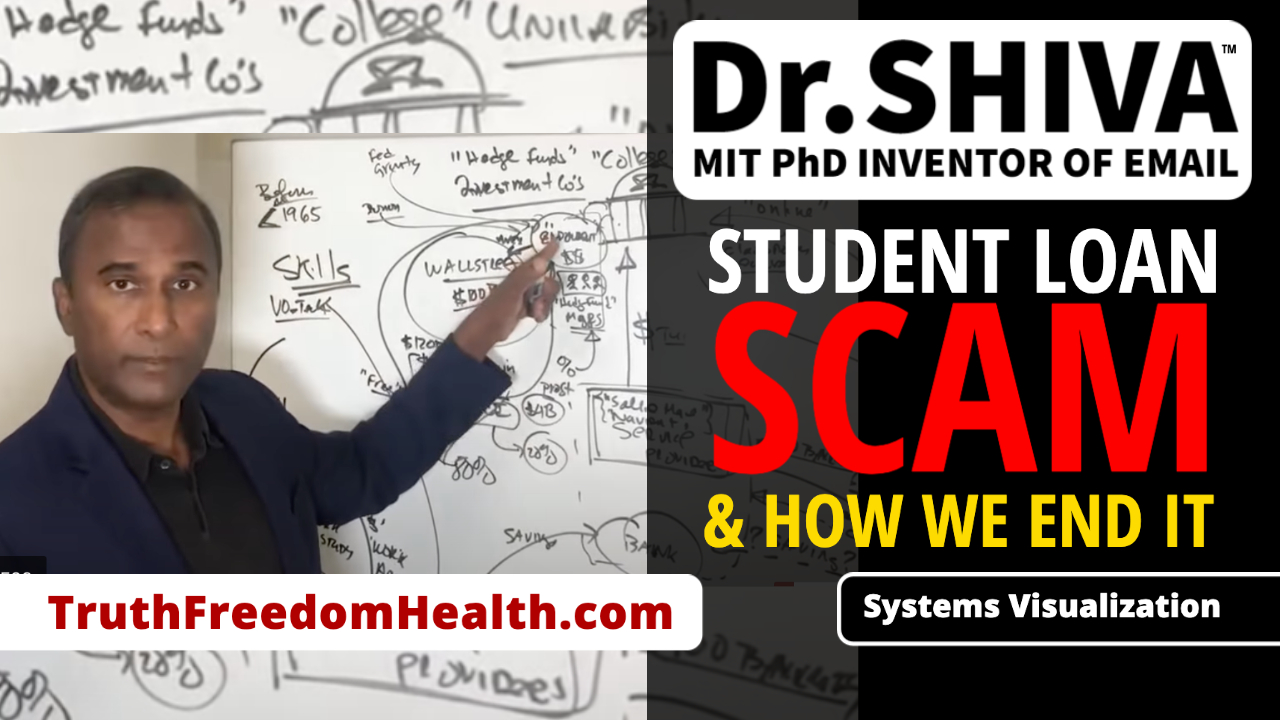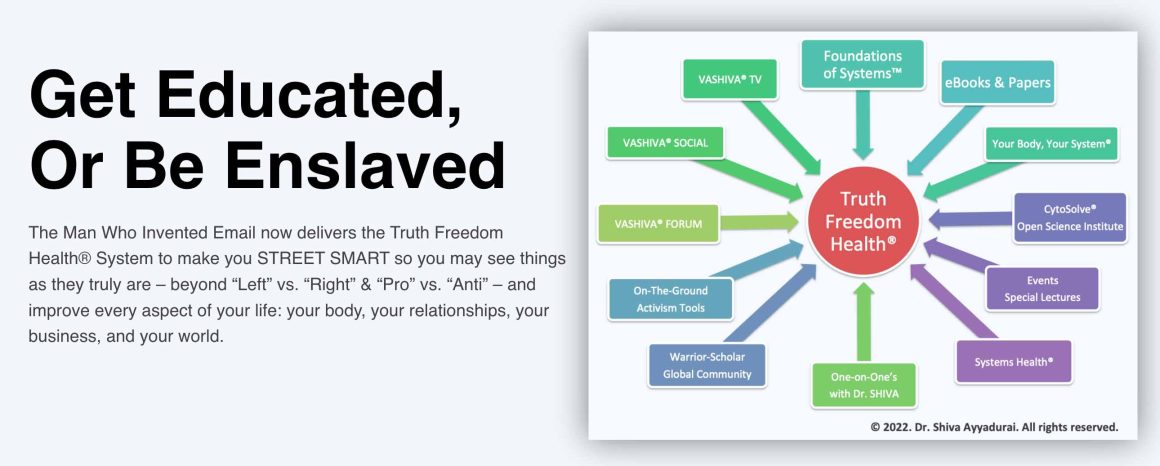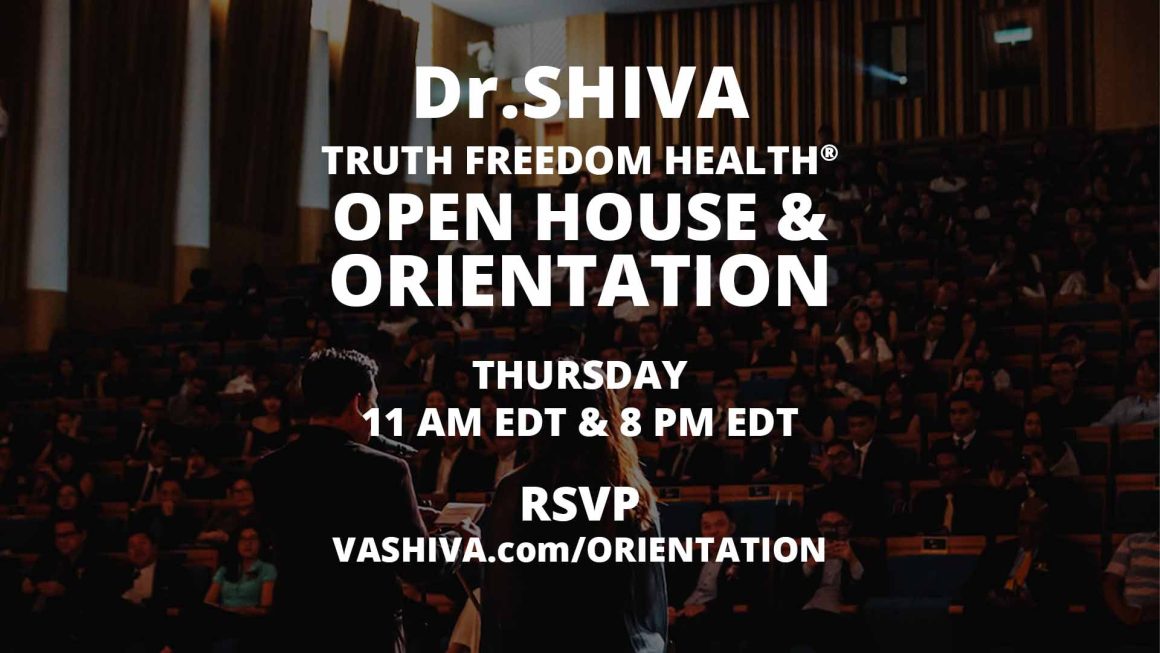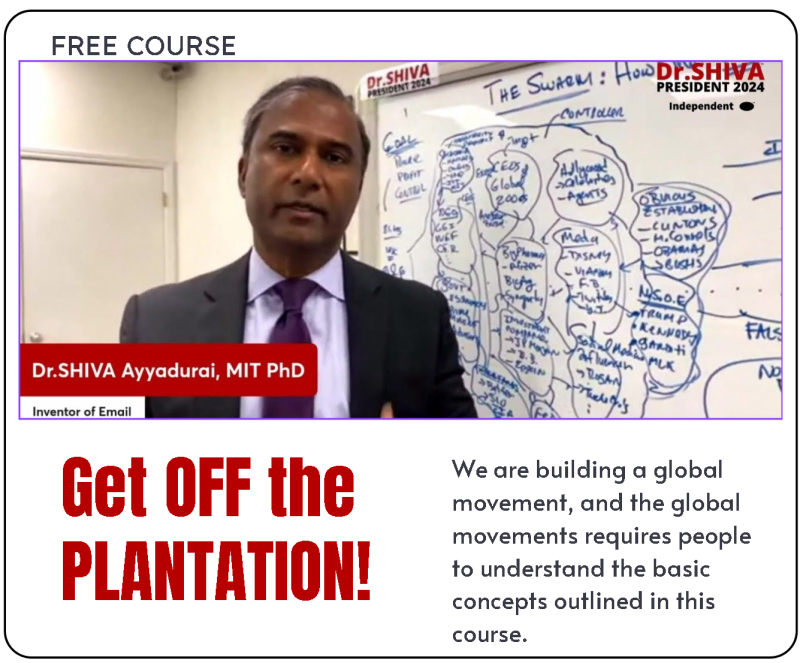
Short 13 Minute Video
Full 23 Minute Video
In this discussion, Dr.SHIVA Ayyadurai, MIT PhD, Inventor of Email, Scientist & Engineer, Candidate for U.S. President, explains how students get entangled in college loans and provides a real solution to this problem with a systems approach.
Become a Truth Freedom Health® Warrior-Scholar

Attend Truth Freedom Health® Thursday Open House

ROUGH TRANSCRIPT (Auto-Generated)
[00:00:00] Hello everyone. This is Dr.SHIVA Ayyadurai. I thought it would be really good to do a nice video explaining student loans and what it means to actually get an education. Here’s your mom and your dad. [00:00:09] Mom’s a little bit taller in this case. Here you are. Your mom and your dad wanted you to do better than them. That was a concept of the American dream. You would go to, typically, some type of guild, some type of master in the old days, or a teacher, and you would give them a little bit of money, [00:00:24] very little money, but typically it was some type of work; what’s called “an apprenticeship,” and in return you got for this a skill. You got a tangible skill. You learned how to be a plumber or an electrician, or you learned how to do really good mathematics so you could later on do surveying or be an engineer, et cetera. But this was this model. But again, you gave some work, you got a skill. Some people call this “work study.” Today, this still exists in what’s called “the trades.” You go here to what’s called a “vo-tech school.” [00:00:50] You can do this while you’re in high school. And in fact, this is still free in a lot of places. It’s a good deal the way the system’s set up. Unfortunately, very few people do this anymore. And again, here you already got some skill out of it. But you were essentially able to become a skilled tradesperson out of this. [00:01:05] You would then go work, or you start your own business and you transacted your skill in this business. You got money for it, [00:01:12] hopefully lots of money. And then as a part of this, you were able to do some savings [00:01:16] into something called a bank. [00:01:17] And then hopefully you could buy different things out of it. So this is pre 1965 around here. Before 1965. Now let’s walk over here. And look at what the situation has become. And when I say I’m gonna choose the date around 1970 till the present, and the reason I choose this day is this is when the Higher Education Act was passed. Higher Education Act. [00:01:40] The Higher Education Act really enabled people to start getting something called loans to go to education. It encouraged people to get into some type of debt to go to get into education. And more importantly, we moved away from the trades and skills… [00:01:53] This was really about skills, [00:01:54] tangible skills. …to this thing called college. College educated became the order of the day, which means your parents felt like, “Wow, for you to be better in the world. I want you to be a college educated man. I want you to get your bachelor’s or your master’s, or maybe even your PhD,” but the notion of college education became the norm over skills-based education. [00:02:12] So what happens here you are again. Here’s your mom and your dad. Again, a major dad, a little bit taller on this side, to be fair. And here you are, the student. And what you wanna do is you want to get a college degree. So over here is an institution, and this was called a college or sometimes a university. Here you were going, not typically to see a master or a skills person, but you were sent over here and you got to be in courses, classrooms, lecture halls. In fact, nowadays you can get a lot of this stuff online. [00:02:42] As a part of this piece, you had to give some type of money here. Most of these colleges today, for example, it can be upwards of $50,000 per year. So for a four year degree, we’re looking at around $200,000. So you gave money. And the goal was, this institution would give you back a degree. [00:03:01] The idea was you give your degree, and hopefully you got something in return. Now, one important thing here was when this transaction took place, did you actually get a skill? Did you actually get a real tangible skill? So this became quite questionable. Did you even have a skill here? [00:03:17] And the reality is, could you even make any dollars from this? So before this was pretty guaranteed. You got a skill. You got money when you went to work. But here, this is become not so clear anymore. This is why we have a lot of students living in their parents’ basements right now. [00:03:31] Because they don’t have… and this is no joke, [00:03:33] they don’t really have a tangible skill from which they can get some money. And it’s questionable whether they can even have any type of savings. So the reason I put a lot of these question marks here is this was a pretty nice future. [00:03:44] You knew where you were going. And if you look here, lots of question marks. You’re unsure if you have skills. You have a degree. No one really knows what that degree is worth. What’s really going on? The Higher Education Act incented the parents, and the child to get what was called “a loan,” to do this. Before, people were a lot more frugal. [00:04:00] They paid as they went, or they were very conservative in this kind of decision making. But all of that has changed, because what’s fundamentally occurred here is, these colleges are not really colleges or institutions where you get an education. They are really hedge funds. [00:04:14] Investment companies. And what you’re gonna see shortly is that you as a student are actually used as a collateral or as a piece of asset, that’s used by this college to get the loans given to them, [00:04:27] And using those loans, they then invest in a place called Wall Street and from that they make a lot of money. So how does this work? You wanna get a degree? You need about $200,000. There’s about 4.5 million people today who have a average loan of around $40,000. And if you multiply that all out, it’s about one point eight trillion dollars in debt. So you wanna get this money, your parents may not have 200k, which is probably the case. So what do they do? They go to these people called service providers. These banks. [00:04:55] We call them service providers. And these service providers include people like, Sallie Mae, you may have heard of these people. Navient. They’re a set of banks, service providers who work with different institutions. They have access to a lot of capital. [00:05:07] And when you want money you apply for a loan. You here are applying for a loan and they approve your loan, but guess what? Do you get that money coming to you? They call it a student loan. [00:05:19] It’s not true. The money directly goes to the institution. The dollar flows here, but you are in debt, the liability is you, you owe money, the money goes from the service provider to the college, but you are in debt here. Very important to remember this. I would argue it should really be called a college university loan because they’re getting it. [00:05:37] This service provider’s giving them the loan. And you are the collateral for that loan. And what this means is, in most loans, if you got a loan from a bank, like for example, some of you run businesses, you go to a bank and you ask for a business loan. Let’s say there’s three different people wanting to start different businesses. [00:05:54] One guy wants to do a donut store, another guy wants to sell aardvarks, another guy wants to have a landscaping business. The bank goes through all of those business plans and they make very judicious decisions. Why? Because a bank, they are accountable because if any of those businesses go bankrupt, that bank loses money and the business has a right to go bankrupt, so they’re very judicious. When these service providers make these loans, there’s a clause called “no bankruptcy.” The student cannot go bankrupt. These service providers have the right to garnish the wage of the students for life, and until they get back their loan paid. [00:06:27] The university gets the money. What does the university do with this money? I talked about the fact that these universities are hedge funds. They’re investment companies. The university takes the money that they get, they put it in a thing called an endowment. It sounds like a beautiful word. Like you hear on PBS. “Endowment.” And they have people, guys here who are called, hedge fund or investment managers who are hired to manage all this pile of money. So this pile of money’s coming in here. Not only they’re getting your tuition money that goes there. They’re getting money from grants. These are our federal grants. They’re getting money from donors and they promote their brand and they get a pile of money. They take this money. And then they invest it. They invest here and the university gets returns. [00:07:08] It’s called a return on investment. And the way this endowment and the hedge fund works, it works like a Wall Street hedge fund. However, they don’t have to pay any taxes. Let me tell you how this works. Hedge funds work the following way. If you and I start at a hedge fund and we took other people’s money. [00:07:23] Let’s say we’re the hedge fund managers, I took a hundred billion dollars in. But let’s say I take in this, I invest about a hundred billion dollars, the endowment or hedge fund’s money. And let’s say that grows by 20%. So the return on that is 20 billion dollars. You got 120 billion, but if you subtract from this, you made a total of 20 billion dollars. [00:07:40] This 20 billion dollars is called your gain. In hedge funds, 80% of this goes back into the people who gave that money. In this case, it goes back into the endowment. I’m gonna put over here. The other 20% is a payout, it’s the profit. So in this case, that’s 4 billion profit. This profit can go back into the endowment, or a portion of it gets to be paid to the hedge fund manager. [00:08:01] So just to give you an idea, Harvard has a 50 billion dollar endowment when they made money, their hedge fund managers, in one year, six guys, five or six guys, got paid 56 million dollars. Think about it. That’s about 8 million dollars, 10 million dollars per person. So these hedge fund guys, this is how they make big commissions. [00:08:19] My point is, let’s just step back a little bit. You’re here as a student, you want to go to college. Your parents don’t have the money. You go to Sallie Mae or Navient, you fill in these loan applications. They give you the loan. Actually, they don’t give you the loan. They say you got the loan. You can’t go bankrupt. [00:08:34] The university now is getting a nice, beautiful pipeline of revenue from you. You’re the asset. You’re used as a collateral, and if you ever go bankrupt, they’re gonna garnish your wages after you graduate. The university, as I said, is a hedge fund. It’s an investment company. [00:08:47] It puts it into this thing called an endowment. And this endowment, let’s say it’s a hundred billion, invests in Wall Street by the way, they could invest in private equity. They have all different types of things. They could put it into real estate. Basically, they’re moving money around. I gave the case 120 billion dollars comes out of this. 20 billion dollars is a gain. 80% may go back into the endowment, 20% is considered profit. And in this case, 4 billion. And either that can go back in here, or you can use that to pay off the hedge fund managers. Now remember this, if private companies did a hedge fund, that 4 billion is taxed at 20% rate. Which would be 800 million dollars. As I mentioned to you, there’s 4.5 million students out there, about 40k a pop in student loans. So that’s roughly, as I mentioned, the 1.8 trillion, in debt that’s out there. [00:09:34] So there’s 1.8 trillion that’s actually owed to these guys. Now, if they’re not able to pay it, guess what happens? The taxpayers, which is you and I and your parents we collectively have guaranteed those loans. So the government is over here somewhere. Let’s say the government is right here with these guys, and the government has backed these loans. [00:09:53] So let’s just look at this. The university gets a great deal whether you fail or not. They get your money, they get to invest it, they get returns, their endowment grows. The Sallie Mae’s and the Navient’s are fine. Just look at their profits, they’ve done beautifully. [00:10:06] You are in debt, and by the way, if everything fails, the $1.8 trillion, we have a big bubble burst. We as a taxpayers are liable for that, which means all of our taxes will go up to cover that loss. So when you look at this entire scam, which is what it is, unfortunately, it was engineered by politicians [00:10:24] somewhere over here, in the halls of Congress. Politicians over here engineered this on behalf of the college people. They engineered this on the behalf of the service providers and Wall Street, and you and I will be stuck with this $1.8 trillion. And you as a student have an unfortunate situation where you won’t even know if you will ever get a job. [00:10:43] So that’s what the situation is. I hope that makes sense here. So what’s the solution? There is a solution, and the solution’s actually quite simple. It’s called a very simple word. It’s called accountability. It’s called making everyone accountable in this. So my solution is when you apply for a loan and you get the loan, [00:10:58] your parents, by the way, may have to co-sign that loan. You may have heard that term, which means if you fail, your parents’ house could be mortgaged. Your parents may have to work for the rest of their lives to pay you off, or may have to sell their assets. What about if we made the university the co-signers? [00:11:13] This is really the solution, one of the big solutions that the first thing we need to do is make the university the co-signers. What that means is that when this loan comes, because they are getting the money, let them back that loan note, which means if you are not successful, if you are not getting on the path to getting the right education, if you are not getting the right skill so you can actually go out and be successful, they should be liable. [00:11:36] Because right now what happens is once they get your money, you know the quality of education here, it’s not the professors and the old guild model is even showing up. They send their graduate students, they send TAs and the professors out. [00:11:47] Like in the case of Elizabeth Warren making $350,000 for teaching one course, the high cost of courses, they’re getting bloated endowments. And everyone’s winning. However, if we have the university co-sign the loan, because many of these universities are telling you how great they are, how they’re gonna help you out, let them put their money where their mouth is, let them co-sign the loan. [00:12:04] The number two thing we should do is these endowments here. Should be taxed at the hedge fund rates. This would mean about 800 million dollars. So if we have 800 million dollars, that’s per year. Think about that. In this case, 50 billion dollars, in the case of Harvard, let’s say 20% return, that’s 10 billion dollars return. [00:12:20] Tax it at the hedge fund rate, 200 million dollars. You put that in a fund and maybe the university takes some of it, but some of it set aside for you. The student because you actually were used as a collateral over here to have this university get that loan. [00:12:34] In summary, in the old days, which was not so far ago, you went to a teacher, a master, you got a skill, you were out there, you were empowered. You went, you had a pretty good idea what you were gonna make. Over here now, you want to go to college. After 1970, the Higher Education Act pushed this. So you go to college, your parents want you to get a college degree. In order to do that, you gotta get a student loan. You can never go bankrupt. The service providers will garnish your wages. The university may or may not give you a skill. [00:12:59] They’ll probably give you a degree, but there’s no accountability. And the university does quite well. All these university endowments have grown beautifully. The administrator’s salaries have gone up beautifully. Not all the times professors, unless you’re Elizabeth Warren, she’s done quite well. [00:13:11] But the bottom line is a student and the family are entering into uncertainty. These people don’t have as much uncertainty. So anyway, I hope this has been helpful. [00:13:19] I hope this video was valuable we’ll have more of them, but keep an eye out for our campaign. Thank you. This is Dr.SHIVA Ayyadurai. Be well.


